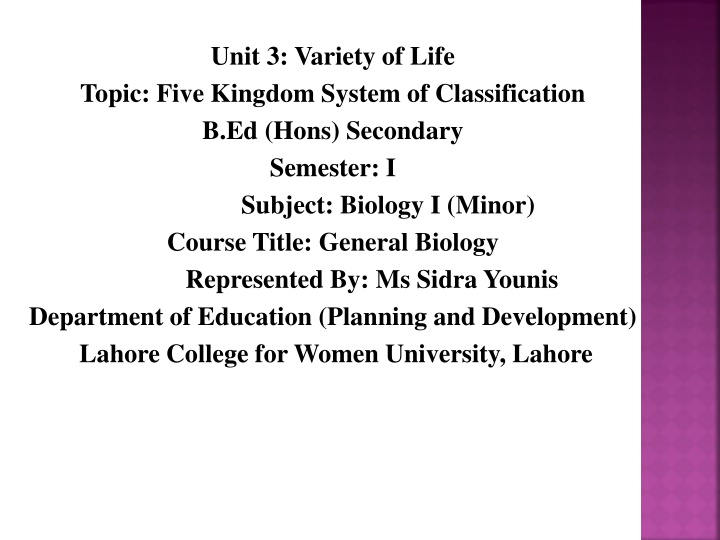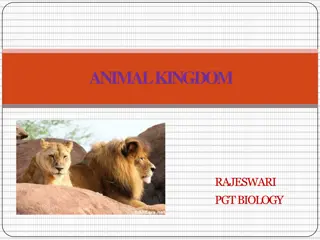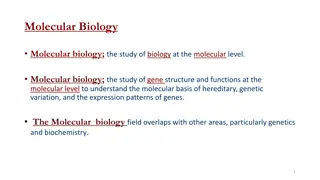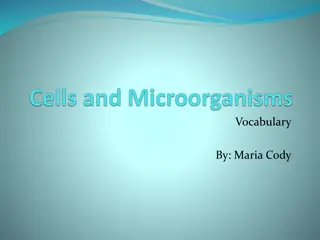Five Kingdom Classification in Biology: An Overview
The five kingdom system of classification, proposed by R.H. Whittaker in 1969, categorizes living organisms into Monera, Protista, Fungi, Plantae, and Animalia based on their characteristics. Each kingdom represents a distinct group of organisms, aiding in a more scientific and natural classification. This system helps in understanding the diversity of life forms and their evolutionary relationships, making it widely accepted in modern biology.
Download Presentation

Please find below an Image/Link to download the presentation.
The content on the website is provided AS IS for your information and personal use only. It may not be sold, licensed, or shared on other websites without obtaining consent from the author.If you encounter any issues during the download, it is possible that the publisher has removed the file from their server.
You are allowed to download the files provided on this website for personal or commercial use, subject to the condition that they are used lawfully. All files are the property of their respective owners.
The content on the website is provided AS IS for your information and personal use only. It may not be sold, licensed, or shared on other websites without obtaining consent from the author.
E N D
Presentation Transcript
Unit 3: Variety of Life Topic: Five Kingdom System of Classification B.Ed (Hons) Secondary Semester: I Subject: Biology I (Minor) Course Title: General Biology Represented By: Ms Sidra Younis Department of Education (Planning and Development) Lahore College for Women University, Lahore
FIVE KINGDOM CLASSIFICATION Organisms are divided into five major kingdoms. R.H Whittaker proposed the five kingdom classification in 1969. The most common system of classification in use today is the five kingdom classification. In this system all living organisms are divided into five kingdoms: The classification of living organisms according to Whittaker into five kingdoms namely are as follows: Kingdom: Monera Kingdo Monera - It consists of primitive organisms. The organisms are very small and single celled. They consists of prokarytotes which includes species like the bacteria, archae bacteria, cyanobacteria and mycoplasma. Example: Bacteria.
CONT Kingdom: Protista Protista are single-celled eukaryotes and are mainlky aquatic. It includes diatoms, golden algae, euglena and protozoans like amoeba, paramoecium, plasmodium etc. They are mostly marine and photosynthetic. Example: Paramoecium Kingdom: Mycota Kingdom Mycota or Kingdom Fungi consists of network of thread-like structures called as mycelium. The bodies consists of long, thread-like structures which are called hyphae. These organisms are mostly saprophytes or parasites and also symbionts. This kingdom of fungi also includes lichens, mycorrhiza, etc. Example: Aspergillus
CONT Kingdom: Metaphyta Kingdom Metaphyta or Kingdom Plantae are eukaryotic, mutlicellular plants. They contain chlororphyll pigment, which helps them prepare their own food by the process of photosynthesis. This kingdom includes all types of plants like herbs, shrubs, trees, flowering and non flowering plants. Example: Rose plant, Mango tree, etc. Kingdom: Metazoa Kingdom Animalia or Kingdom Metazoa are heterotrophic, eukaryotic, multicellular organisms. They lack cell wall. This kingdom includes all types of animals. Example: Lion, Peacock, etc.
Merits of Five Kingdom Classification This system of classification is more scientific and natural. It is the most accepted system of modern classification as the different groups of animals are placed phylogenetically. The prokaryotes are placed in a separate kingdom as they differ from all other organisms in their organization. As the unicellular organisms are placed under the kingdom protista, it has solved many problem related to the position of organisms like euglena. The fungi totally differ from other primitive eukarytotes hence, placing the group fungi in a status of kingdom is justifiable. The kingdom Plantae and Animalia shows the phylogeny of different life styles, in the five kingdom classification, they are more homogeneous group than the two kingdom classification. This system of classification clearly indicates cellular organization and modes of nutrition, the character which have appeared very early in the evolution of life.
Demerits of Five Kingdom Classification The Kingdom of Monerans and the Protists include diverse, heterogenous forms of life. In both the kingdoms there are autoptrophic and hetertrophic organisms. They also include organisms which have cells with cell wall and cells without cell wall. All the organisms of these three kingdoms do not originate from a single ancestor. Multicellular organisms have originated from protists several times. Organisms like the unicelluar green algae like volvox and chlamydomonas have not been included under the Kingdom Protista because of their resemblance to other greeen algae. The general organization of the slime moulds are completely different from the members of protists. In this system of classification viruses have not been given proper place.























